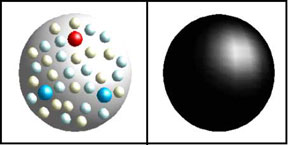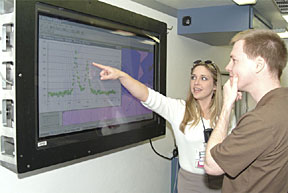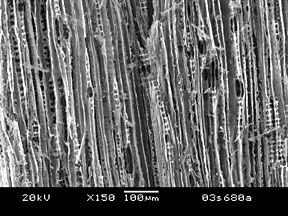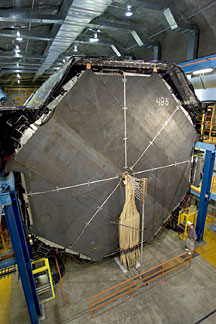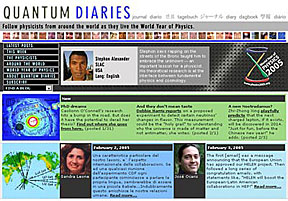Research
Highlights...
|
 |
| Number 177 |
February 14, 2005 |
|
Examining bacteria, one cell at a time
Researchers at DOE's Argonne National Laboratory have found a new way to study individual living bacteria cells and analyze their chemistry. The scientists used high-energy X-ray fluorescence measurements to determine differences between free-floating, or planktonic, and surface-adhered, or biofilm, cells of bacteria exposed to hexavalent chromium, a heavy-metal contaminant and carcinogen. The biofilm cells were more tolerant of the contaminant, while it damaged or killed the planktonic cells. In addition to determining the chemical differences between the cells, the work pioneers a revolutionary new technique, setting the stage for studies defining mineral-metal-microbe interactions in contaminated environments. No previously available techniques had the spatial resolution needed to analyze individual bacterial cells noninvasively and nondestructively.
[Donna Jones Pelkie, 630/252-5501,
djpelkie@anl.gov]
|
|
Linking descriptions of the proton
|
The proton's appearance changes, depending on the energy used to probe it. Here, it appears as a sum of quarks loosely bound by gluons and as a rigid object. |
The ubiquitous proton takes on a different persona depending on how its snapshot is taken. When probed with particle accelerators using high energies, the proton appears as a sum of quarks loosely bound by gluons; at very low energies, the proton appears as a rigid object. Thus, physicists use different theories to describe proton structure probed at different energies. Now, new data from DOE's Jefferson Lab link these descriptions. Physicists formed a quantity called the “Bjorken sum” by combining data on the spin structure of protons and neutrons. This quantity can help describe proton structure in all energy regimes.
[Kandice Carter, 757/269-7263,
kcarter@jlab.org]
|
|
Better bond coat performance
Using fundamental information from an initial study of the high-temperature phase equilibria in the Ni-Al-Pt system, researchers at DOE's Ames Laboratory and Iowa State University developed novel bond coat (BC) alloy compositions for advanced thermal barrier coating (TBC) systems that result in remarkable performance improvements. Their technology defines a composition range of Ni-Al-Pt-based alloys that deliver unprecedented oxidation resistance and phase stability compared to existing BC compositions based on the ß-NiAl system. Demonstrating up to a 20-fold performance improvement over existing technologies, their invention may significantly increase the durability and reliability of TBCs used on turbine engine components. Also, the new BC compositions will help engine designers increase the operating temperature and efficiency of the engines.
[Saren Johnston, 515/294-3474,
sarenj@ameslab.gov]
|
|
Floating mount takes plasma screens on the road
|
SRNL Plasma Screen Floating Mount |
Manufacturers typically recommend against mounting large plasma screen displays in environments where shock and vibration occur—like in moving vehicles. Researchers at DOE's Savannah River National Laboratory, however, needed to use a 42-inch plasma display screen in a mobile surveillance laboratory, so SRNL engineers created a unique floating mount that enables the use of such display screens within mobile vehicles. The patented SRNL Plasma Screen Floating Mount provides stable, interference-free video, computer graphics, and scientific modeling displays. Its lightweight frame allows the plasma display to “float,” which eliminates vibration and dampens shock from external impacts, such as pot holes or rough terrain, preventing damage to the gas-filled glass platen and other sensitive electronics of the screen.
[Angeline French, 803/725-2854,
Angeline.French@srs.gov]
|
|
PNNL petrifies wood in record time
|
SOAKED, DRIED & PETRIFIED: An electron microscopic image shows a cross section of wood that was artificially petrified in days, mimicking a natural process that takes millions of years. |
Scientists at DOE's Pacific Northwest National Laboratory have converted wood to mineral, achieving in days what takes nature millions of years. They start by giving a 1 centimeter cube of pine (pictured) or poplar a two-day acid bath, then soak it in a silica solution for two more, dry it, pop it into an argon-filled furnace gradually cranked up to 1,400 degrees centigrade to cook for two hours, and let it cool in argon to room temperature. The silica takes up permanent residence with the carbon left in the cellulose to form an exact replicate of the wood in silicon carbide, or SiC, a new ceramic that, because of its enormous surface area, may prove useful in industrial chemical separations or filtering pollutants from gaseous effluents.
[Bill Cannon, 509/375-3732,
cannon@pnl.gov]
|
|
|
Fermilab's Debbie Harris observes neutrinos and family with equal fervor
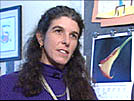 |
Debbie Harris believes physicists need to share their enthusiasms with the public. |
When the MINOS experiment sends its first neutrinos from the Department of Energy's Fermilab to the Soudan Underground Laboratory in Minnesota this month, Debbie Harris will have the inside scoop.
Harris is describing her experiences throughout 2005 for Quantum Diaries, a collection of on-line journals by more than two dozen young physicists from around the globe celebrating the World Year of Physics. The mother of two children, Isaac (7) and Sonia (4), Harris likened the experiment to child development in her entry for Jan. 22, 2005: “So if the beamline was ‘born' on December 3 when we sent the first protons through the entire beamline, then the baby took it first steps today when we put a target in the way of those protons, and finally produced a neutrino beam. We are still not ready to start the official ‘run,' but we want to test what we already have in place to make a neutrino beam, and a few things need to be finished before we can run at the high intensity we ultimately have to achieve.”
|
The 6,000-ton MINOS detector, a half-mile underground in a former iron mine in Soudan, Minnesota. (Fermilab photo) |
MINOS (Main Injector Neutrino Oscillation Search) will send neutrinos through the earth (no tunnel needed) from the lab to a 6,000-ton steel-and-scintillator detector, a half-mile underground in the former Soudan iron mine. The 450-mile trip will take 2.5 milliseconds. Neutrinos carry no charge. They rarely interact with other forms of matter, yet they are so abundant that billions pass through us at any given moment. Of the trillions that the experiment will send to Soudan each year, only about 1500 will leave traces in the detector. Scientists will determine whether the neutrinos have changed from one kind to another (“oscillation”), and Harris will document the progress.
“I think it's important that physicists try to share their enthusiasm with the public,” she says, “since it is the public whose taxes go to fund the research. I have to confess to another motive, too--that is to show that ‘mothers of young children' can be physicists, and that they aren't somehow terrible or uninvolved mothers (or terrible or uninvolved physicists) because of their work.”
Submitted by DOE's
Fermilab
|
|


